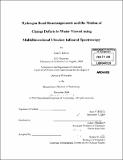| dc.contributor.advisor | Andrei Tokmakoff. | en_US |
| dc.contributor.author | Roberts, Sean T. (Sean Thomas) | en_US |
| dc.contributor.other | Massachusetts Institute of Technology. Dept. of Chemistry. | en_US |
| dc.date.accessioned | 2010-08-30T14:31:24Z | |
| dc.date.available | 2010-08-30T14:31:24Z | |
| dc.date.copyright | 2010 | en_US |
| dc.date.issued | 2010 | en_US |
| dc.identifier.uri | http://hdl.handle.net/1721.1/57678 | |
| dc.description | Thesis (Ph. D.)--Massachusetts Institute of Technology, Dept. of Chemistry, February 2010. | en_US |
| dc.description | "December 2009." Cataloged from PDF version of thesis. Vita. | en_US |
| dc.description | Includes bibliographical references. | en_US |
| dc.description.abstract | Compared with other molecular liquids, water is highly structured due to its ability to form up to four hydrogen bonds to its nearest neighbors, resulting in a tetrahedral network of molecules. However, this network is highly dynamic, exhibiting fluctuations and rearrangements that take place on femtosecond to picosecond time scales. The transport of excess protons and proton holes in water makes exclusive use of water's hydrogen bonding network. Compared to ions of similar size and charge density, both hydronium and hydroxide ions exhibit anomalously high diffusion rates due to the fact that water molecules that neighbor these ions can undergo a proton transfer reaction with the ion. This allows the structural diffusion of the ion to occur apart from the displacement of individual water molecules. In this thesis we adopt a joint experimental and theoretical approach to characterize the fluctuations of water's hydrogen bonding network and how these fluctuations act to drive the structural diffusion of the aqueous hydroxide ion. The experimental data that we present consists of a series of ultrafast nonlinear infrared spectroscopies, in particular two-dimensional infrared spectroscopy (2D IR), applied to the O-H stretching transition of a dilute solution of HOD in NaOD/D20. The frequency of the O-H stretch, (OH, is highly sensitive to the configuration of its hydrogen bonding partner. 2D IR spectroscopy allows us to measure rapid shifts in OH that reveal time scales for changes in the local environment of the HOD molecule. | en_US |
| dc.description.abstract | (cont.) The calculation of 2D IR spectra from molecular dynamics simulations then allows us to make a direct connection between the results of our experiments and the underlying dynamics of the system that drive both hydrogen bond exchange and the structural diffusion of the hydroxide ion. 2D IR spectra recorded for dilute HOD in D20 show a strong asymmetry, preferentially broadening in the frequency region indicative of strained or broken hydrogen bonds, indicating that these configurations are unstable and quickly return to a hydrogen bond. The time scale over which the 2D spectra broaden, ~60 fs, is similar to the librational period of water and suggests that molecules exchange hydrogen bonding partners though rapid, large amplitude rotations. Molecular dynamics simulations find that the transition state for hydrogen bond exchange resembles a bifurcated hydrogen bond. In roughly half of the examined exchange events, a second solvation shell water molecule inserts across the breaking hydrogen bond. This suggests that hydrogen bond rearrangements are tied to the restructuring of a water molecule's solvation shell. Upon the addition of NaOD to HOD/D20 solution, a large absorption continuum appears to the low frequency side of the O-H stretch due to the formation of strong hydrogen bonds between HOD molecules and OD ions. At early waiting times, 2D IR spectra show large, offdiagonal intensity in this frequency range that rapidly relaxes within ~110 fs. | en_US |
| dc.description.abstract | (cont.) Modeling using an empirical valence bond simulation (MS-EVB) model of aqueous NaOH suggests that as the 0-H stretching potential symmetrizes during proton transfer events, overtone transitions of the shared proton contribute strongly to 2D spectra. The rapid loss of offdiagonal intensity results from the spectral sweeping of these vibrational overtones as the solvent modulates the motion of the shared proton. The collective electric field of the solvent is found to be an appropriate reaction coordinate for the formation and modulation of shared proton states. Over picosecond waiting times, spectral features appear in the 2D IR spectra that are indicative of the exchange of population between OH~ ions and HOD molecules due to proton transfer. The construction of a spectral fitting model gives a lower bound of 3 ps for this exchange. Calculations of structural parameters following proton exchange using the MS-EVB simulation model suggest that the observed exchange process corresponds to the formation and breakage of hydrogen bonds donated by the HOD/OD~ pair formed as a result of the proton transfer. A full description of the structural diffusion of the hydroxide ion requires both a description of the local hydrogen bonding structure of the ion as well as the dielectric fluctuations of the surrounding solvent. | en_US |
| dc.description.statementofresponsibility | by Sean T. Roberts. | en_US |
| dc.format.extent | 337 p. | en_US |
| dc.language.iso | eng | en_US |
| dc.publisher | Massachusetts Institute of Technology | en_US |
| dc.rights | M.I.T. theses are protected by
copyright. They may be viewed from this source for any purpose, but
reproduction or distribution in any format is prohibited without written
permission. See provided URL for inquiries about permission. | en_US |
| dc.rights.uri | http://dspace.mit.edu/handle/1721.1/7582 | en_US |
| dc.subject | Chemistry. | en_US |
| dc.title | Hydrogen bond rearrangements and the motion of charge defects in water viewed using multidimensional ultrafast infrared spectroscopy | en_US |
| dc.type | Thesis | en_US |
| dc.description.degree | Ph.D. | en_US |
| dc.contributor.department | Massachusetts Institute of Technology. Department of Chemistry | |
| dc.identifier.oclc | 630714831 | en_US |
